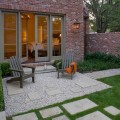English Formal Garden
Its purpose of an English formal garden is to create a scene that offers the viewer an idealized portrait of Nature. This style originated in England during the 18th Century, where panoramic paintings of sweeping landscapes with groves of trees, rolling lawns, tranquil lakes, and pastoral vistas inspired a garden design that sought to recreate these elements in microcosm.
Clearly recognizable geometry helps define the aesthetic of an English formal garden. This geometry is centered on a dividing line that runs the entirety of its length. Plant materials and decorative elements are then equally balanced on either side of this line, lending the garden its sense of symmetry and order. These materials are normally arranged in segments composed of interlocking geometric shapes. They can be squares, triangles, or rectangles, and they can be made from any number of shrubs, flowering plants, or herbs (see knot garden for details on using herbs to create geometry).
The English formal garden is then completed with some type of unifying focal point that is placed in the very center. Due to the fact that this is a much more “relaxed” formal style than say, Italian or French, the use of classical sculptures is very rare in an English garden. Instead, geometric organic elements or water elements are used to create geometry symmetry throughout the design. Topiaries or small trees, for example, can add beautiful vertical impact to the scene. Flower beds can be used to center the garden on rich patterns of color. Or, any number of water features can be used to create either a sense of controlled, vibrant fluidity or calm, grounded tranquility.
An English formal garden uses a variety of vegetation types to achieve its end. Climbers are often planted at the bases of boundary fences or walls to cover them with greenery. Garden interiors are also decorated with trees and shrubs that sometimes spill slightly over the bed edges. This further contributes to the English sense of relaxed formality. Another popular element is an herb planting. Herbs are ideal for creating the rich, interlocking patterns reminiscent of Celtic art motifs that experienced a strong revival during the English Renaissance.
Annuals can create very rich interlocking patterns that look almost like embroidery when viewed from above. At the same time, less or ornate but equally colorful patterns can be created using more traditional flower beds. Flower bed focal points can make the entire garden the premier spot on the landscape when populated with species such as Columbines, Aster, Carnations, Cornflowers, and Black-Eyed Susans.
English formal gardens also use inorganic forms primarily in three primary places: the central dividing line, the focal point (if a non-organic element is chosen), and in boundary fences or walls. The purpose of any boundary wall or fence is to create a sense of comfortable privacy and containment of vital organic energy. Masonry walls are ideal for creating this effect, although in some cases they may create too much isolation from the Houston landscape. In traditional Tudor gardens, stone walls were often used, but in America, fences covered with climbers have been substituted to allow some view outward into the rest of the yard.
Central paths are almost always made from either red brick or gravel. Small trees and shrubs line these paths to create a sense of Natures immediate presence. This makes the path more than simply a transit area, and turns a thoroughfare into an aesthetic in its own right.
Larger English formal gardens may also be built with topiaries sculpted in the shape of a canopy, an arbor or a pergola. This creates a shaded area (or two) where a small bench can be placed so people can sit and survey the garden from a comfortable position within its interior.
Water is often a very important part of an English formal garden as well. While this is not an absolute must-have for this design, water nevertheless adds a strong, positive aesthetic any time that it is incorporated into the theme. Any number of water features work well for emulating the presence of water in a natural setting. Small rectangular reflecting pools can compliment both garden form and home architecture. Birdbath, water spouts, or custom fountains can add vertical impact. Or, a simple, quaint, natural pond can be used to add a sense of tranquility and calm repose to the moment.

